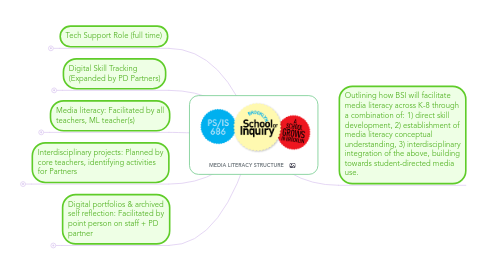
1. Tech Support Role (full time)
1.1. Responds to staff Google Form for reporting tech issues
1.1.1. CHALLENGE: People aren't reporting things that don't work. False sense of security. Routine updates needed
1.2. Purchasing plan supports goals (tablets, digitizing center, BYOD)
1.3. "Mouse Sqad": a club facilitated by tech support staff
1.4. Parent volunteers guided by tech support staff
1.5. Routine updates of all equipment
2. Digital Skill Tracking (Expanded by PD Partners)
2.1. K-2: est. basic skills through center time activities and group tech projects
2.1.1. Teacher planned collaborative productions
2.1.2. Photography basics through digital portfolio archiving and reflection workshops
2.1.3. Grade 2 digital process intro (end of year)
2.1.3.1. Password mgmt in 2
2.1.3.2. Logging into GAFE
2.1.3.3. Typing boot camp
2.1.3.4. Accessing Google Classroom
2.1.4. Awareness of online communication
2.1.4.1. Skype
2.1.5. Awareness of online authorship
2.1.6. Operations on iPad/computer K-1
2.2. 3-5: Push-in support build skills into units of study
2.2.1. GAFE account use
2.2.2. Doc formatting
2.2.3. Adding to student portfolios
2.2.4. Intro to production platforms connected to small-scale class projects (coordinated with ML teacher)
2.2.4.1. Video/Photo shooting basics
2.2.4.2. Video Editing
2.2.4.3. Coding/game design
2.2.4.4. Making 3D design/printing
2.2.4.5. Graphic design
2.3. Student access to digital skill mentors (i.e. PD personel or teachers) by appointment/elective: applied use in Middle School
2.3.1. Students sign up for support based on needs of interdisciplinary self-directed projects
2.3.2. Supported by in house partners that bring in experts to expand student potential
2.4. BSI provides a formula for partners to follow (rubric for activating content)
3. Media literacy: Facilitated by all teachers, ML teacher(s)
3.1. K-8 Scope & Sequence: Developing skills & habits of mind for media analysis and mindful production
3.2. K-2 building blocks of media analysis integrated in classroom curriculum (coordinated with The Media Spot & skill dev partner)
3.2.1. Communication through web
3.2.2. Portfolio archiving (scaffolded)
3.2.3. Content analysis (reading modeled/co-planned by media lit teacher)
3.2.4. Metacognition about participation in scaffolded class, small group, or individual productions
3.3. 3-5 ML established through mindful media analysis/activities/production/reflection in ML cluster and integrated in ELA, SS, etc.
3.3.1. Digital citizenship supported by Acceptable Use Poliycy and
3.3.2. Research Fundamentals
3.3.3. Peer Editing/Collaboration in ELA
3.3.4. Online management of interdisciplinary ML/ELA/SS projects
3.3.5. Writing/Publishing (media texts); demonstrating mindful use of different media languages (text/image, video, web)
3.3.6. Intro to range of production types integrated in traditional curriculum (PSA, data use, info graphic, game design, web design) (coordinated with Digital Skill partners)
3.4. MS: demonstrated through -- independent content analysis, routine reflection on mediated scholarly and social life; management and application of skills/knowledge within interdisciplinary projects
4. Interdisciplinary projects: Planned by core teachers, identifying activities for Partners
4.1. Starts in 4/5 between ML/ELA/SS
4.2. Staple of Middle School
4.3. Applied tech skills & media literacy
4.4. Media Use Assessment
4.4.1. Rubric for execution
4.4.2. Rubric for effectiveness of strategy and media choices
4.4.3. Self assessment/reflection on choices and limitations
